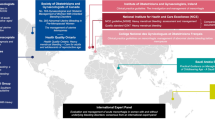Abstract
In women of fertile age, iron loss consequent to excessive menstrual discharge is by far the most frequent cause of iron-deficient anemia. However, the relationship between menstrual discharge and iron loss is poorly understood. In this prospective study, total menstrual and iron losses were assayed in a large cohort of non-anemic women and women with excessive menstrual blood losses (menorrhagia) in order to provide data useful for intervention. One hundred and five Caucasian women aged 20–45 years were recruited. Blood cell count and serum ferritin (SF) levels were determined in each case before menses. Menstrual fluid losses (MFL) were determined using a standardized pads’ weight method. Hematin concentration was assayed by a variant of the Alkaline Hematin Method from which iron concentration was calculated. Mean SF levels were 36.2 (range 8.6–100) ng/ml in healthy women and 6.4 (range 5–14) ng/ml in patients with menorrhagia. Median values of iron lost/cycle were 0.87 mg in healthy women and 5.2 mg in patients with menorrhagia (ranges 0.102–2.569 and 1.634–8.665 mg, respectively, p < 0.001). In women with menorrhagia, iron lost/cycle strongly correlated (0.789, p < 0.001) with MFL. In conclusion, healthy women with normal menses lose, on average, 1 mg iron/cycle. Average iron losses in patients with menorrhagia are, at least in our cohort, on average, five-to-six times higher than normal. Most women with menorrhagia had totally depleted iron stores. Indirect, quantitative evaluation of iron lost with menses may be useful to assess the risk of developing iron-deficient anemia in individual patients.



Similar content being viewed by others
References
Finberg KE (2011) Unraveling mechanisms regulating systemic iron homeostasis. Hematology Am Soc Hematol Educ Program 2011:532–537
Zhang AS, Enns CA (2009) Molecular mechanisms of normal iron homeostasis. Hematology Am Soc Hematol Educ Program 2009:207–214
Okonko DO, Mandal AK, Missouris CG, Poole-Wilson PA (2011) Disordered iron homeostasis in chronic heart failure: prevalence, predictors, relation to anemia, exercise capacity, and survival. J Am Coll Cardiol 58:1241–1251
Charlton RW, Bothwell TH (1982) Definition, prevalence and prevention of iron deficiency. Clin Haematol 11:309–325
Cook JD (1982) Clinical evaluation of iron deficiency. Semin Hematol 19:6–18
Hallberg L, Rossander-Hultén L (1991) Iron requirements in menstruating women. Am J Clin Nutr 54:1047–1058
Fraser IS, McCarron G, Markham R (1984) A preliminary study of factors influencing perception of menstrual blood loss volume. Am J Obstet Gynecol 149:788–793
Fraser IS, McCarron G, Markham R, Resta T (1985) Blood and total fluid content of menstrual discharge. Obstet Gynecol 65:194–198
Warner PE, Critchley HO, Lumsden MA et al (2004) Menorrhagia II: is the 80-mL blood loss criterion useful in management of complaint of menorrhagia? Am J Obstet Gynecol 190:1224–1229
Warner PE, Critchley HO, Lumsden MA et al (2004) Menorrhagia I: measured blood loss, clinical features, and outcome in women with heavy periods: a survey with follow-up data. Am J Obstet Gynecol 190:1216–1223
Strong J (2010) Hematinic deficiencies. In: Pavord S, Hunt B (eds) The Obstetric Hematology Manual. Cambridge University Press, Cambridge, pp 13–27
Shaw ST Jr, Aaronson DE, Moyer DL (1972) Quantitation of menstrual blood loss − further evaluation of the alkaline hematin method. Contraception 5:497–513
Società Italiana di Ginecologia e Ostetricia (2008) Flussi mestruali abbondanti. Via dei Soldati, 25 Roma (Italy), www.sigo.it.
Rodeghiero F, Castaman G, Tosetto A et al (2005) The discriminant power of bleeding history for the diagnosis of type I von Willebrand disease: an international, multicenter study. J Thromb Haemost 3:2619–2626
Hallberg L, Nilsson L (1964) Determination of menstrual blood loss. Scand J Clin Lab Invest 16:244–248
Nilsson L, Sölvell L (1967) Clinical studies on oral contraceptives–a randomized, doubleblind, crossover, study of 4 different preparations (Anovlar mite, Lyndiol mite, Ovulen, and Volidan). Acta Obstet Gynecol Scand 46(Suppl 8):1–31
Guillebaud J, Bonnar J, Morehead J, Matthews A (1976) Menstrual blood-loss with intrauterine devices. Lancet 1:387–390
Price DC, Forsythe EM, Cohn SH, Cronkite EP (1964) The study of menstrual and other blood loss, and consequent iron deficiency, by Fe59 whole-body counting. Can Med Assoc J 90:51–54
Hallberg L, Nilsson L (1964) Constancy of individual menstrual blood loss. Acta Obstet Gynecol Scand 43:352–359
Rybo G, Hallberg L (1966) Influence of heredity and environment on normal menstrual blood loss. A study of twins. Acta Obstet Gynecol Scand 45:389–410
Acknowledgments
The authors would like to thank all physicians and women involved in this study.
Authors’ contributions
Mariasanta Napolitano and Guglielmo Mariani ideated the work and wrote the paper. Alberto Dolce performed the statistical analysis of results. Mariasanta Napolitano, Elvira Grandone, Sergio Siragusa, Assunta Orecchioni enrolled patients and critically revised the results. Giuseppe Celenza and Maria Grazia Perilli supported the laboratory research. Gaspare Carta contributed to the study design and enrolment. Guglielmo Mariani critically revised all the research process. All the authors have significantly contributed to the research; they have read and approved the submitted version of the article.
In addition to institutional funds, an unrestricted grant from Novo Nordisk helped to conduct the study.
Conflict of interest
The authors declare that they have no conflicts of interest.
Author information
Authors and Affiliations
Corresponding author
Rights and permissions
About this article
Cite this article
Napolitano, M., Dolce, A., Celenza, G. et al. Iron-dependent erythropoiesis in women with excessive menstrual blood losses and women with normal menses. Ann Hematol 93, 557–563 (2014). https://doi.org/10.1007/s00277-013-1901-3
Received:
Accepted:
Published:
Issue Date:
DOI: https://doi.org/10.1007/s00277-013-1901-3




